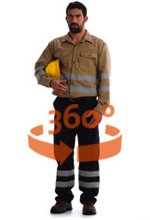FR SHIRTS AND PANTS
Contamos con Camisas y Pantalones confeccionados con telas ignífugas certificadas, con opción a cintas reflectivas ignífugas de ser necesario.
FR Shirt: button-down collar with button closure. Two chest pockets with flaps and button. Cuffs with button closure. All buttons are non-metallic.
FR Pants: Modern design. Non-metallic zipper. Two front pockets, two back patch pockets and a coin pocket. Seven belt loops on the waist.
Double stitched and bar tacked with FR thread to provide a better tear and fire resistance.
FR Pants: Modern design. Non-metallic zipper. Two front pockets, two back patch pockets and a coin pocket. Seven belt loops on the waist.
Double stitched and bar tacked with FR thread to provide a better tear and fire resistance.

American standard which establishes that employees who are exposed to a possible arc flash should wear appropriate flame resistant garment for the risk level of their workplace. Employers must evaluate an arc flash to determinate the risk of potential energy and the limit of protection against the arc flash.
The protective garment should cover the calculated incident energy or risk level, reaching at least its minimum ATPV.
Arc Thermal Performance Value - ATPV
Arc Thermal Performance Value - ATPV
- Level 0: No risk
- Level 1: between 4 to 7.9 cal/cm2
- Level 2: between 8 to 24.9 cal/cm2
- Level 3: between 25 to 39.9 cal/cm2

American standard for garments that protect from flash fire. The standard demands that after being washed a hundred times, the garment is put on a mannequin and exposed to 3 seconds of direct flame. In order to accomplish the standard the result must show less than 50% of body burn.

For Molten aluminium splashes (code D) the garment must classify at least at level D1.
Molten iron splashes (code E) the garment must classify at least at level E1
Level |
Molten Aluminium (g) |
|
Min. |
Max. |
|
D1 |
100 |
< 200 |
D2 |
200 |
< 350 |
D3 |
350 |
|
Level |
Molten iron (g) |
|
Min. |
Max. |
|
E1 |
60 |
< 120 |
E2 |
120 |
< 200 |
E3 |
200 |
|

The standard classifies High-Visibility Safety Apparel (HVSA) as Performance Class 1, 2 or 3, depending on the amount of visible background and retroreflective material. These Performance Classes give users a way to specify HVSA that is appropriate for the work environment and hazards. The 2015 edition also establishes three types of garments:
- Type O (off-road), for non-roadway use, where workers are not exposed to high traffic or temporary control zones. Type O HVSA is Performance Class 1.
- Type R (roadway), for use where workers are exposed to traffic from public access highway rights-of-way or roadway temporary control zones. Type R HVSA may be Performance Class 2 or 3.
- Type P (public safety) for emergency and incident responders and law enforcement personnel who are exposed to struck-by hazards in roadway or off-road work environments. These garments provide additional options addressing competing hazards or the need for access to special equipment. Type P HVSA may be Performance Class 2 or 3
 EN
EN  ES
ES 

 ©Copyright 2025 Geotex SRL
©Copyright 2025 Geotex SRL